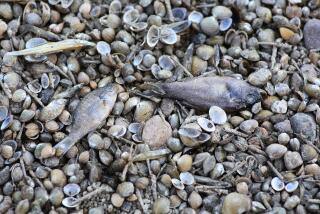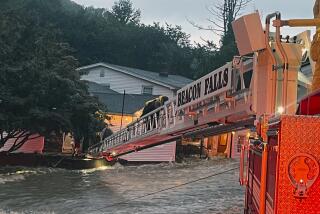THE MIDWEST FLOODS : Environmental Enemies Lurk in the Murky Water
- Share via
The destructive force wrought by the flooding of the Mississippi River will continue to take its toll long after the turbid waters reced to normal levels. Nutrient overloading of tributaries along the Mississippi will cause the depletion of its fish population. Restoration can take months to a few years, a prospect that commercial and sport fishing interests are dreading. However, the effects of flooding are not all bad. Sediment deposits on wetlands strengthen and even reclaim previously lost marshland habitats. This benefits plant life and wildlife that depend on the wetlands for food and shelter.
The Problems Upstream
1) Debris. Refuse carried by the flooded river settles on the river’s bottom or washes up on flooded basins.
2) Oxygen loss. Rapid decomposition of organic matter robs the water of oxygen while releasing carbon dioxide. The more organic material is deposited in a river bottom, the more oxygen is used. Warm water temperatures help speed up the decomposition process.
3) Starvation. The murky water adds to the problem by preventing photosynthesis of plant material, which normally provides fish with food. Fish that depend on the waterways for sustenance and oxygen are starved. Waterlogged flood plains will be stripped of most topsoil and plants.
4) Chemical spills. Oil leaks and chemical spills contribute to the contamination of water on the Mississippi River and its tributaries. In some areas, it will take weeks before water quality can be normalized.
The Problems Downstream
The impact of a flooded Mississippi River goes beyond the physical damage that the states along the upper Mississippi have witnessed. Its impact goes down deep to the continental shelf of the Gulf of Mexico and deep into the pockets of the fishing industry. River outflows deposit organic material into the ocean to create pockets of dense, oxygen-depleted water columns called “dead zones.”
How “Dead Zones” Are Formed
1) Warm, fresh water pushes colder dense salt water down the continental shelf.
2) Organic material carried by the river settles in the lower half of the now stratified water.
3) As nutrients from the organic material break down, oxygen levels drop to dangerously low levels in pockets called “dead zones.” These zones have oxygen levels of 2 milligrams per liter, which is insufficient to sustain fish life.
4) These water columns will move with the ocean current of river flow.
The Opportunities
Flooding on the Mississippi River brings with it an abundance of water and sediment that help thinning wetlands.
A) Sediment acts as the foundation of most wetland habitats. It replenishes lost nutrients in the soil.
B) Flooding water keeps wetlands moist by raising ground water levels.
Habitats in Harm’s Way
The upper reaches of the Mississippi River, where most of the flooding has occurred, is home to numerous wildlife refuges and fishery research facilities. Most of these refuges serve as rest stops for dozens of migrating North American birds and are home to indigenous birds. Fishery facilities along the Mississippi are the primary providers of fish stock in the region. here are the locations of facilities and refuges run by the U.S. Fish and Wildlife Service:
Blessing, Curse for Birds
The Mississippi Valley is one of the main corridors for migrating North American birds. They include thed Canada goose, white-fronted goose, mallard, common (green-winged) teal, wood duck, whooping crane, buff-breasted sandpiper, least tern, redheaded woodpecker, veery, bobolink, dickcissel and Leconte’s sparrow. Long-term prospects do not seem as rosy. Sustained flooding will leave most of their habitats devoid of plants. Food for the migrating birds will also be scarce because of water contamination.
Fishing in “dead zones” will yield a minimal catch, if any. Once an area of water has been depleted of oxygen, fish and other marine animals will move away. This phenomenon can affect areas as large as 5,000 square miles.
“Dead zones” can occur in 17 to 200 feet of water, 3 to 37 miles offshore and can extend up to 70 feet from the ocean bottom.
Impact on Protected Wildlife
The impact of the flooding on endangered and threatened species cannot be determined until after waters recede and a thorough investigation is completed. These are some of the species feared to be the most likely to suffer or have suffered because of the flooding:
Birds: Most birds will lose nesting sites--such as low-lying islands, sandbars and trees on flood plains. Food will also be scarce because of the high, murky water.
BALD EAGLE, LEAST TERN, PIPING PLOVER
Fish: Fish species will lose suitable stream habitats because of faster currents and increased contamination.
NIANGUA DARTER, OZARK CAVEFISH, PALLID STURGEON, NEOSHO MADTOM, FRESHWATER MUSSELS
(unionids)--Species include Higgins’ eye pearly mussel, Curtis’ pearly mussel, fat pocketbook pearly mussel, pink mucket pearly mussel, winged mapleleaf freshwater mussel.
Mammals: Two species of bats are affected. Both will lose hunting and roosting habitats and possibly most of the caves that the species use for winter hibernation.
INDIANA BAT, GRAY BAT
Plants: Three plant species under federal protection may be wiped out by the effects of flooding. Long-term submergence will be the primary cause of decline. Overload of silt deposits will also rob the soil of nutrients and oxygen.
DECURRENT FALSE ASTER, RUNNING BUFFALO CLOVER, PONDBERRY
More to Read
Sign up for Essential California
The most important California stories and recommendations in your inbox every morning.
You may occasionally receive promotional content from the Los Angeles Times.









